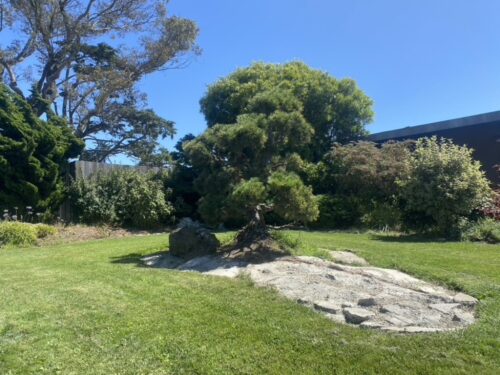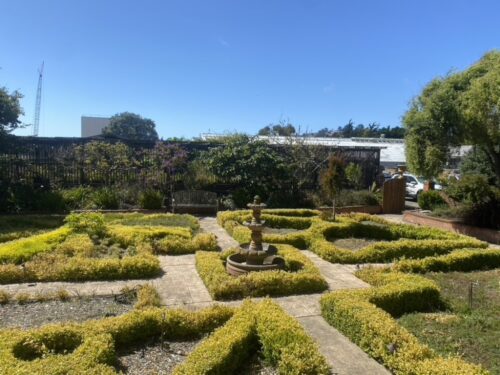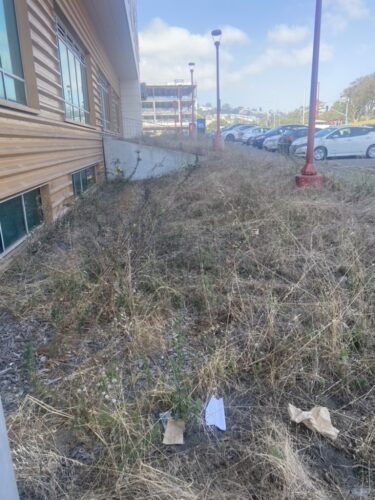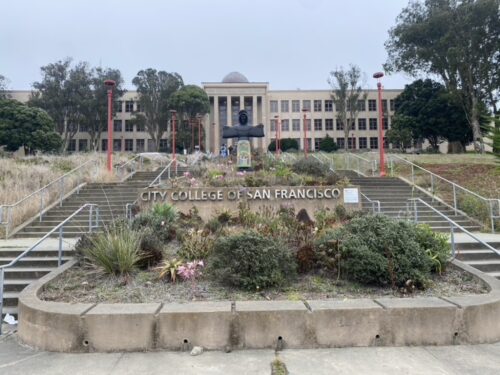In the Weeds: City College Struggles With Maintaining Landscaping
By Ilgiz Khisamov
Out of over a hundred community colleges in California, City College stands out, its superb football team notwithstanding, for its impressive collection of public art, a couple of old-school buildings, and a decent horticulture department. One would think that the green spaces on the main campus would be on par with the lushness that is Golden Gate Park, with trees and shrubbery that accentuates the treasured murals and statues and offers students shade and respite from the westerly winds and noisy city life.
Sadly, if one strolls through the Ocean campus, one soon discovers that the landscaping is no Japanese Tea Garden or Fuchsia Dell, but looks more like Candlestick Park after an illegal rave. If you are a garden-minded person, you will notice that green spaces that were designed with great care and aesthetic foresight visibly suffer from years of neglect. The signs of blight are everywhere. Delicate maples behind Rosenberg Library have sunburnt crowns, and pittosporums along Frida Kahlo look more unkempt than an Ashbury Wook. Everything is choking on tons of weeds, encroaching on sidewalks.

For understandable reasons, the only bright spot is the garden within the horticulture department and the green spaces around it.
So what happened? Where did things go wrong for campus landscaping that used to be so good-looking?
Well, a cursory look over mentions of City College in the news reveals that it is beset with myriad problems. An accreditation crisis hangs like a sword of Damocles over the whole school. The chancellor recently announced that he is not returning next year. There is a lot of political tension between the students and the faculty on one side and the management on the other, complicated further by some individuals crossing over to the other side. Such things as weeds or dying trees are given little to no priority. Consequently, the greenery on campus suffers.
Gardening is a labor of love, but a tough, labor-intensive job and often as demanding as a City College professor. Maintaining an attractive garden usually has to be preventative. Otherwise, you risk losing your trees. The administration has said they have improved the college and its prospects. Still, unless it shows in the way the college presents itself through its gardens, the general public’s perception will be that the City College is perennially wilting away.

City College is a significant institution in San Francisco that has uplifted many people and provides essential services and enrichment for the public. It would be a sad story to see it slowly wither away due to mismanagement or lack of strategic thinking. Appearances do matter. For the City College to thrive, not only does it have to address the needs of students, faculty, and the public, but close attention must be given to creating a genuinely revolutionary green space on campus. This could be a landscape that is equal parts pleasing to view and to be in that captures tons of carbon, is primarily native, pollinator, and bird-friendly, and a place that beckons and comforts. After all, the city has a reputation to uphold. If you want to be called the AI capital of the world, go ahead, but make sure your roots are firmly in the ground and your youth has a fantastic place for learning.

Steve Brown, the Chair of the Horticulture Department and one of the few, if not the only, vocal partisans for the campus trees and shrubbery, says the campus has only two gardeners on staff, whereas it should have at least nine. He adds that the two guys are extremely good at what they do, but there is only so much they can do within 40 hours a week. His efforts to get better care for landscaping have been both Sysiphian and akin to warnings of Cassandra. Although he is also a co-chair of the Facilities Committee overseeing landscaping, his attempts to hire more gardeners have mainly been ignored. Exasperated, he says, “I’ve tried everything I can to get people on board with helping to maintain the campus with staffing. The gardeners believe they should be staffed, which doesn’t happen. So, you know, I can only put so much energy out trying to get this stuff taken care of while I’m still trying to do my job and five other people’s jobs in my department.”

In an illuminating example of how mismanagement costs more long-term, Professor Brown relates how many trees fell on campus, damaging students’ cars but luckily not hurting anyone. “I have often suggested that the college have an arborist that they have an agreement with and pay to come on campus and maintain our trees.” If that plan had been in place, most of the fallen trees would still be standing and fulfilling their roles of shade-giving and carbon-capturing. Instead, penny-pinching on preventative care resulted in spending considerable money to have “some arborists come and chop up the trees and clean up the mess.”

An official with the facilities department, unwilling to go on record, attested that the Grounds Division needs to be more funded and staffed. They agreed with the labor union that there should be nine complete staff gardeners. They only have two. Still, they expressed optimism at the direction of the campus and the current leadership. That was shared, however, before the current chancellor announced his decision to leave at the end of this school year.
Written queries with Campus Administration went unanswered, but at a Facilities Committee meeting Alberto Vasques, head of Facilities and Capital Planning, answered a few questions about the sorry state of campus landscaping and what are, if any, plans to mitigate its state. Evidently they intend to hire three more gardeners by the end of this semester. As for improving and embellishing the campus greenery, he made it clear “that the landscape projects that will happen in the near future will be safety-driven.” In other words, the concern is avoiding liabilities and safeguarding the bottom line rather than creating an attractive and sustainable learning environment.

An informal survey of students showed that when asked their opinion of campus landscaping, most found it unkempt and neglected. Jamie Tara, a second-year PolySci major, wishes there were more trees and native plants. She says, “It honestly could do with better care so they would look healthier.” Morganne Juelich, in the Addiction and Recovery Program, observes a lot of dead trees around campus. “I would definitely like more flowers around and more upkeep.”
As part of the accreditation process, City College commissioned an environmental review that would form a part of its vision for the college in years to come. The review envisions “a park-like atmosphere at the campus with plazas offering views within the campus and vistas showing the surrounding cityscape. The plazas would provide spaces for student gatherings and collaboration.” So the intent is there; it remains to be seen when and if such attractive visions would be put into practice.

Bravo. One can learn on many layers with writing like this.
Obviously you love the school and the plants to the full extent words can convey. I too thought the campuses were beautiful in SF, but these photos take away the gloss and excitement that most people just feel to be there, and they and this article reveal the tragic folly of letting vivacious, curious, and generous plant life recede into our concrete shadow.
Concrete rage, pavement saw, stone circles, Joni Mitchell… were all the songs in vain?